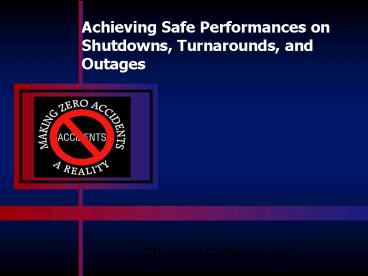Achieving Safe Performances on Shutdowns, Turnarounds, and Outages - PowerPoint PPT Presentation
1 / 35
Title:
Achieving Safe Performances on Shutdowns, Turnarounds, and Outages
Description:
CII Annual Conference 2001. Achieving Safe Performances on Shutdowns, Turnarounds, ... When the Revenue Stream Stops. 9. When do Shutdowns Occur? Components ... – PowerPoint PPT presentation
Number of Views:1241
Avg rating:3.0/5.0
Title: Achieving Safe Performances on Shutdowns, Turnarounds, and Outages
1
Achieving Safe Performances on Shutdowns,
Turnarounds, and Outages
2
Nine Industry Best Practices
- Getting to Zero
- Demonstrated management commitment
- Staffing for safety
- Safety planning pre-project / pre-task
- Safety training and education
- Worker involvement and participation
- Recognition and rewards
- Subcontractor management
- Accident/incident reporting and investigation
- Drug and alcohol testing
3
What are Shutdowns, Turnarounds and Outages?
4
The terms Shutdown Turnaround and Outage
are often used interchangeably. There is no
clear discernible difference between them, but
some terms are used more by some industry sectors
than they are in others.For example, in a power
plant a shutdown might often be called an outage,
while in a paper plant a shutdown might be called
a turnaround. However, both would also know them
as shutdowns.
5
We shall use the term Shutdown
- A shutdown occurs when work must stop in
operating facilities that are generally in active
production of some product, including paper,
plastics, electrical power, pharmaceuticals,
various petroleum products, and so on. This
cessation of work is mandated when repairs must
be done, upgrades installed, components replaced,
etc.
6
Shutdowns are costly to the owners
- Facility owners realize a continuous flow of
revenues when a process plant is functioning.
This revenue flow comes to a complete halt if the
plant must be shut down for some reason. - But plants must be shut down for various reasons.
This is inevitable.
7
Raw Products
Finished Products
8
Raw Products
Finished Products
When the Revenue Stream Stops
9
When do Shutdowns Occur?
- Components Break Down (emergency)
- Routine wear and tear (scheduled replacements and
repair) - Upgrading components (scheduled)
10
(No Transcript)
11
Shutdowns Require Many Construction Workers to be
Hired in a Short Time
Worker Build-up is Fast
12
Shutdown Projects
Number of Workers
Conventional Construction Projects
Project Duration
13
Work is Performed Around the Clock Often With 7
12-hour days per Worker
2 Shifts are Common
14
Unique nature of shutdowns and turnarounds
- Key Difference From Conventional Construction
Projects - Rapid Buildup of the Workforce
- Tight Schedule (Round the Clock Effort)
15
Shutdowns are not conducive to safety
16
What are the Implications for Safety?
- Workers start every shift with the worksite
having been altered (they must re-orient
themselves each day) - Workers work lots of overtime and can get
fatigued - Work is crowded and intense, so everyone needs to
know what is going on
17
Short Term Work Activities Shutdowns,
Turnarounds and Outages
- Methodology one study
- 44 Projects involving Shutdowns,
Turnarounds and Outages - Personal Interviews
18
Zero Accidents Study2000/2001
- Detailed interviews on Shutdown, Turnaround and
Outage projects - 44 Projects
- Petrochemical
- Industrial
- Power
- Paper Products
- U.S. wide geographic area
19
Best Practice Results
- Over 20 key findings revealed companies utilizing
these best practices have significantly lower
recordable injury rates.
20
Zero Accidents Study2000/2001
- Of the forty-four (44) construction projects,
- Twenty-two (22) projects achieved zero OSHA
recordable injuries. - Thirty-eight (38) had zero lost time injuries.
21
Participating Firms Generally had Very Good
Safety Records
- They are the best of the best.
22
The Workforce
- Where do the workers come from?
23
Safety Planning and Scheduling
- Is software used to schedule the project?
24
Safety Planning and Scheduling
- What are the units of time used on the project
schedule?
25
Worker Familiarity and Scheduling by the Hour
26
Duration of the Shutdown
27
What is the Typical Crew Size?
28
Safety Planning and Scheduling
- Is pre-task planning a regular part of project
planning?
29
Safety Training and Education
- Do new field employees receive orientation to the
project?
30
Safety Culture??
- Are safety glasses, with side shields, required?
31
Type of Contract Arrangement
32
Is there a Safety Incentive in the Contract?
33
Best Practices
- Getting to Zero
- Demonstrated management commitment
- Staffing for safety
- Safety planning pre-project / pre-task
- Safety training and education
- Worker involvement and participation
- Recognition and rewards
- Subcontractor management
- Accident/incident reporting and investigation
- Drug and alcohol testing
34
Project Safety Performance
- Results of implementing best practices
2.37
0.79
0 workers per 1000
0.00
35
Which practice is the most important to achieving
zero accidents?
The safety culture of a firm is evident in
everything it does. We must be ever vigilant in
our efforts as we strive for Zero Accidents.
There is no Silver Bullet































